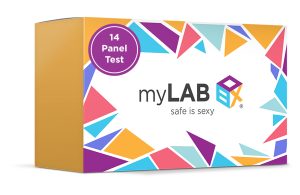Herpes Home Test, Everything You Need To Know

You’re considering an at home genital herpes test but there are a lot of questions flying through your head. What exactly is genital herpes? What are some signs that I have herpes?
To really understand everything you need to know about taking an at-home genital herpes test, you first need to know about the infection and how to avoid it.
Herpes is an amazingly common sexually transmitted infection, but did you know that you can protect yourself from it with myLAB Box’s herpes home test?
In today’s uncertain world, STDs are constantly on the rise. For example, one in three Americans have a sexually transmitted infection. In fact, herpes in particular is absolutely the most common infection in the United States.
Using a home genital herpes testing kit is a no-brainer. After all, genital herpes is one of the most common sexually transmitted infections. Unfortunately, it is also very contagious, so you definitely want to take a test regardless of whether you are experiencing symptoms.
The Facts: Herpes Simplex Virus
The Herpes Simplex Virus (HSV) is a sexually transmitted infection that is categorized by two types of viruses: herpes simplex type 1 (HSV-1, or oral herpes) and herpes simplex type 2 (HSV-2, or genital herpes).
What is HSV-2?
Genital herpes is one of the most common sexually transmitted infections (STI) in the United States. In fact, one in six people in the U.S. between the ages of 14 and 49 have genital herpes. You can contract this infection through oral, anal or vaginal sex. Since it usually appears in the form of blisters or sores, it can easily be mistaken as a blemish or ingrown hair.
However, just because there are no symptoms doesn’t mean that there is no infection. Many times, there are no visible signs or symptoms to alert you of this infection’s presence. Instead, the only way to know for sure whether you have this STI is to use a herpes test. This step is the most vital one of all. Not getting tested also means not being diagnosed and treated. In turn, you can potentially spread the infection, and cause unnecessary health complications for yourself and others.
Both types of herpes have spread like wildfire throughout the United States in recent years. According to the Centers for Disease Control and Prevention, genital herpes is actually the third most common STI. In fact, it is estimated that one out of every six people between the ages of 14 and 49 have contracted genital herpes.
This massive infection rate is largely due to the way that herpes is spread. The virus is carried in fluids found in easily breakable herpes sores. Having direct contact with those fluids can cause you to contract the infection. It is transmitted through vaginal, anal, or oral sex with a person who has the disease.
The Stealthy Symptoms of Herpes
Having herpes doesn’t necessarily mean that you’ll immediately be seeing telltale signs. In fact, it’s possible that you won’t show any visible symptoms at all.[1][2] The symptoms that do show up are often mild enough to be completely unrecognized as the infection. In short, many people who have herpes may not even know it. Then it is that much easier to pass it on to someone else.
For oral herpes, or HSV-1, the carrier may see common “fever sores” or “cold sores” around his or her mouth. Now you’re probably thinking about everyone you’ve ever met who has complained of a cold sore. Maybe you get cold sores yourself. That is how rampant herpes has become!
For Men, a penile infection can include uncomfortable symptoms such as sores on or around the penis, swelling or discomfort in the groin nodes.
For Women, a vaginal or pelvic infection can be a telltale sign of genital herpes. This includes symptoms such as a discomfort that is similar to a yeast, bacterial or bladder infection. In addition, sores in or around the vagina, vulva or urethra and bleeding between periods may occur. In addition, it is possible to pass herpes to an infant, which can be fatal (neonatal herpes).
An infected person with genital herpes, or HSV-2, may have blisters and bumps around the genitals or rectum. These blisters can break and result in painful sores. During the very first outbreak, you may also display flu-like symptoms such as fever, body aches or swollen glands.
What’s more, both versions of HSV can be passed to partners whether or not the carrier is showing symptoms. Knowing the status of your own sexual health, as well as that of your sexual partners, is the best way to stay safe. Testing is the only way to be able to know “what is HSV” and what is not.
If visible, here are some of the more common signs of an HSV-2 infection:
Vaginal or Pelvic Infection:
- Discomfort similar to a yeast, bacterial or bladder infection
- Sores in or around the vagina, vulva or urethra
- Bleeding between periods
- Pain while urinating
- Headaches, body aches or flu-like symptoms
Penile Infection:
- Sores on or around the penis
- Pain while urinating
- Swelling or discomfort in the groin nodes
- Headaches, body aches or flu-like symptoms
Remember, both oral and genital herpes can be spread even if sores are not present.[3]Most cases of genital herpes are caused by HSV-2, but if you participate in oral sex, keep in mind that the oral variety of HSV can still cause genital herpes. So it pays to test regularly and be honest with your partners.
Is There a Cure For Herpes?
Unfortunately, there is no known cure for either type of herpes. Once you are infected, you are usually a carrier for life.
It’s not all bad news, though! Herpes symptoms can be treated and relieved with the proper medication. These can lower the frequency of your outbreaks and relieve the pain that comes with the symptoms. These treatments can also shorten the amount of time that each outbreak lasts. Some can even make it less likely for the HSV infection to be passed on to your partner.
Take a Herpes Home Test from myLAB Box
Getting tested is the only way to know whether or not you have herpes. Knowing your status and taking control of your own sexual health is quite simply the best way to guard against the transmission of this infection. Encouraging your partner to also get tested is the only way to be sure that you don’t contract it from others.
HSV-2 Genital Herpes Testing Kit Options
Genital Herpes Testing Kit specifically screens for genital herpes HSV-2. This is a popular option for those who think or know that they have been in contact with this infection.
Uber Box (8-panel test kit) screens for HIV (I & II), Hepatitis C, HSV-2, Syphilis, Chlamydia, Gonorrhea, and Trichomoniasis.
Love Box (Uber Box x2) includes two Uber Box test kits so partners can test together.
At Home 14-Panel Total Box Test is the most comprehensive at-home test on the market. myLAB Box’s 14-panel test screens for the most common sexually transmitted diseases in the United States. This includes: HIV (I & II), Hepatitis C, HSV-2, Syphilis, Chlamydia (genital, throat and rectal), Gonorrhea (genital, throat and rectal), Trichomoniasis, Mycoplasma genitalium. Women who are 30 years of age or older can add an HPV option. You can also add an optional HPV test.
Here’s how it works:
- Order a home testing kit online. (You even get free shipping!)
- Collect a sample using the easy-to-follow instructions.
- Send the sample off for testing. (More free shipping!)
- Receive your lab-certified results online in just days.
Herpes and Pregnant Women
For pregnant women, there are additional reasons to fear genital herpes. As an example, the infection can be passed on to the baby. Ultimately, this may lead to miscarriage or premature birth. Prenatal herpes, which can be fatal, is also a possible complication for the fetus.
Herpes and HIV
Anyone who contracts HSV-2 will be at greater risk for HIV. The sores often associated with herpes can break easily. HIV is transferred through blood, so these broken sores are easy access points for infection when they come into contact with the mouth, vagina, or rectum of someone who is HIV-positive. In the end, it increases your chances of contracting the virus. A herpes at home test will better help you assess your risks.
Although there is no cure for HSV-2, symptoms can be managed and maintained. This is why it is even more important to be tested. When you use a genital herpes testing kit, you get accurate results from the comfort of home.
With proper care, the frequency of outbreaks can greatly diminish. If you test positive using myLAB Box’s HSV-2 herpes home test kit, we’ll connect you with a physician or sexual health expert for a free phone consultation. If you live in a state that allows telemedicine (and most do!), this physician can even prescribe your treatment. The right medication can even shorten the amount of time that each outbreak lasts.
You can order a herpes home test from myLAB Box. These tests can be taken any time, any place, and offer lab-certified results that can be checked discreetly online. Regular testing is the best protection. Because safe really is sexy.
How Often Should I Get an STD Test?
Again, HSV-2 is very common, so regular testing is recommended. We put together a guide to help quickly inform you on the different times to test for HSV-2 and other STIs. Set a schedule for routine screenings. This will give you total control over your sexual health.
Reviewed by Luis Ferdinand M. Papa, MD, MHA
References:
-
[1] Study found that only 45% of persons diagnosed with genital herpes had symptoms.
Cowan F M, Johnson A M, Ashley R, Corey L, Mindel A. Antibody to herpes simplex virus type 2 as serological marker of sexual lifestyle in populations. British Medical Journal. 1994.
-
[2] Study concluded that almost 40% of new genital herpes infections and two out of three new oral herpes infections are symptomatic.
Andria G.M. Langenberg, M.D., Lawrence Corey, M.D., et al. A Prospective Study of New Infections with Herpes Simplex Virus Type 1 and Type 2. New England Journal of Medicine. 1999.
-
[3] Study found that asymptomatic carriers of genital herpes are shedding the virus in genital fluid 10.2% of the time in a given month. Symptomatic carriers shed at a rate of 20.1%.
Tronstein E, Johnston C, Huang M, et al. Genital Shedding of Herpes Simplex Virus Among Symptomatic and Asymptomatic Persons With HSV-2 Infection. Journal of the American Medical Association. 2011.
Popular Tests

Total Box
14 Panel STD Test
In Stock – Free Shipping
$369 – $399
